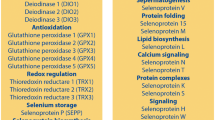Abstract
Plasma levels of selenium (Se) were determined consecutively during a menstrual cycle of six women in three phases (i.e., menses, follicular, and luteal). To detect possible differences in relation to normal pregnancy, plasma levels of Se were also determined in paired samples of maternal and umbilical cord blood from 12 pregnant women. No periodic changes in the plasma Se levels were observed during the menstrual cycle. The intraindividual variation, estimated by coefficients of variation, ranged from 1.9% to 9.9% among the menstrual phases of the subjects. The plasma Se level during pregnancy did not differ significantly from those of nonpregnant women, and those in the second trimester and at delivery were at similar levels (1.58±.14 and 1.48±.20 µmol/L, respectively). Compared to the levels of maternal Se at delivery, the fetal cord plasma at birth had a significant lower Se level (1.23±.34 µmol/L, p<.05).
Similar content being viewed by others
References
G. F. Combs and W. P. Gray, Chemopreventive agents: selenium, Pharmacol. Ther. 79, 179–192 (1998).
J. Chaudiere and R. Ferrari-Iliou, Intracellular antioxidants: from chemical to biochemical mechanisms, Food Chem. Toxicol. 37, 949–962 (1999).
T. Yoshioka, M. Mori, Y. Takehara, et al., Blood and tissue levels of lipoperoxides in rats during development, Biol. Neonate 41, 155–160 (1982).
J. Neve, Selenium and pregnancy, Rev. Fr. Gynecol. Obstet. 85, 29–33 (1990) (in French, with English abstract).
K. Das and A. R. Chowdhury, Metallic ion concentration during menstrual cycle in normally menstruating women, Indian J. Med. Sci. 51, 52–54 (1997).
Ministry of Health and Welfare, Recommended Dietary Allowances, Dietary Reference Intakes, 6th ed., Daiichi Shuppan, Tokyo (1999) (in Japanese).
J. H. Watkinson, Fluorometric determination of selenium in biological material with 2,3-diaminonaphthalene, Anal. Chem. 38, 92–97 (1966).
T. Suzuki, T. Hongo, T. Ohba, et al., The relation of dietary selenium to erythrocyte and plasma selenium concentrations in Japanese college women, Nutr. Res. 9, 839–848 (1998).
K. Karita and T. Suzuki, Fish eating and variations in selenium and mercury levels in plasma and erythrocytes in free-living healthy Japanese men, Biol. Trace Element Res. 90, 71–81 (2002).
E. Halmesmaki, G. Alfthan, and O. Ylikorkala, Selenium in pregnancy: effect of maternal drinking, Obstet. Gynecol. 68, 602–605 (1986).
W. Wasowicz, P. Wolkanin, m. Bednarski, et al., Plasma trace element concentrations in maternal and umbilical cord blood in Poland. Relation with birth weight, gestational age and parity, Biol. Trace Element Res. 38, 205–215 (1993).
P. J. Dison, G. Lockitch, A. C. Halstead, et al., Influence of maternal factors on cord and neonatal plasma micronutrient levels, Am. J. Perinatol. 10, 30–35 (1993).
A. M. Lee, G. Huel, J. Godin, et al., Inter-individual variation of selenium in maternal plasma, cord plasma and placenta, Sci. Total Environ. 159, 119–127 (1995).
G. Gathwala, O. P. Yadav, I. Singh, et al., Maternal and cord plasma selenium levels in full-term neonates, Indian J. Pediatr. 67, 729–731 (2000).
D. Micetic-Turk, E. Rossipal, M. Krachler, et al., Maternal selenium status in Slovenia and its impact on the selenium concentration of umbilical cord serum and colostrums, Eur. J. Clin. Nutr. 54, 522–524 (2000).
K. Sekine, M. Kimura, and Y. Itokawa, Selenium content and glutathione peroxidase activity in the red blood cell in nonpregnant and pregnant women, Jpn. J. Hyg. 44, 699–704 (1989).
O. A. Levander, P. B. Moser, and V. C. Morris, Dietary selenium intake and selenium concentrations of plasma, erythrocytes, and breast milk in pregnant and postpartum lactation and nonlactating women, Am. J. Clin. Nutr. 46, 694–698 (1987).
H. Guvenc, F. Karatas, M. Guvenc, et al., Low levels of selenium in mothers and their newborns in pregnancies with a neural tube defect, Pediatrics 95, 879–882 (1995).
J. O. Odland, E. Nieboer, N. Romanova, et al., Concentrations of essential trace elements in maternal serum and the effect on birth weight and newborn body mass index in sub-arctic and arctic populations of Norway and Russia, Acta. Obstet. Gynecol. Scand. 78, 605–614 (1999).
G. Huel, D. Campagna, F. Girard, et al., Does selenium reduce the risk of threatened preterm delivery associated with placental cytochrome P450-1A1 activity? Environ. Res. 84, 228–233 (2000).
K. Karita, S. Sasaki, J. Ishihara, et al., Validity of a self-administered food frequency questionnaire used in the 5-year follow-up survey of the JPHC study to assess selenium intake: Comparison with dietary records and blood levels, J. Epidemiol. 13(Suppl.), S92-S97 (2003).
B. A. Dolamore, J. Brown, B. A. Darlow, et al., Selenium status of Christchurch infants and the effect of diet, NZ Med. J. 105, 139–142 (1992).
S. Bro, H. Berendtsen, J. Norgaard, et al., Serum selenium concentration in maternal and umbilical cord blood. Relation to course and outcome of pregnancy, J. Trace Elements Electrolytes Health Dis. 2, 165–169 (1998).
R. S. Bedwal and A. Bahuguna, Zinc, copper and selenium in reproduction. Experientia 50, 626–640 (1994).
Author information
Authors and Affiliations
Rights and permissions
About this article
Cite this article
Karita, K., Takano, T., Satoh, K. et al. Variations in plasma selenium levels as a result of the menstrual cycle and pregnancy in healthy Japanese women. Biol Trace Elem Res 99, 83–91 (2004). https://doi.org/10.1385/BTER:99:1-3:083
Received:
Accepted:
Issue Date:
DOI: https://doi.org/10.1385/BTER:99:1-3:083




